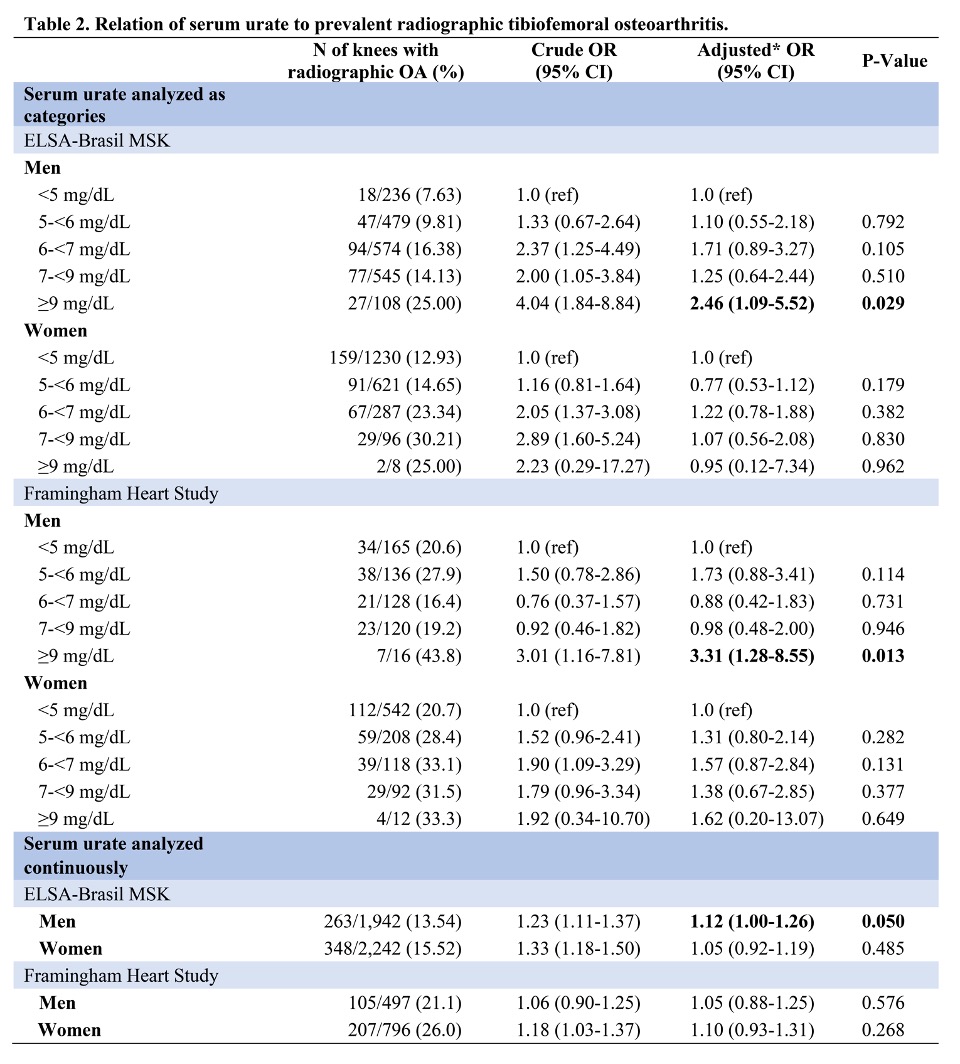Session Information
Session Type: Poster Session C
Session Time: 8:30AM-10:30AM
Background/Purpose: Hyperuricemia may contribute to the development and/or progression of knee osteoarthritis (OA), based on increased inflammation associated with elevated serum urate (SU). Because hyperuricemia and OA are both associated with obesity, the direction and magnitude of the relation between them need to be thoroughly evaluated, taking the body mass index (BMI) into account. The identification of SU as a modifiable factor in the pathogenesis of OA could lead to the trial use of urate-lowering drugs as potential adjuvant therapy for OA. Therefore, we evaluated the relation of SU to radiographic knee OA (ROA) in two large cohorts unselected for OA, accounting for BMI.
Methods: This was a cross-sectional analysis of the Brazilian Longitudinal Study of Adult Health – Musculoskeletal Study (ELSA-Brasil MSK) cohort, mirroring a previous analysis performed on the original cohort of the Framingham Heart Study (FHS), comparing the results of these two populations. The ELSA-Brasil MSK is an ancillary study of ELSA-Brasil and comprises 2,901 individuals with data on musculoskeletal health at baseline, including knees and hands radiographs. For the present analysis, we selected subjects ≥50 years older. In the ELSA-Brasil MSK, SU was assessed at visit 1 (2008-2010) and ROA at visit 2 (2012-2014); in the FHS, SU was assessed at exams 20 and 21 (1986-1992) and ROA at exam 22 (1990-1994) in original cohort. ROA of each tibiofemoral joint was defined as KL ≥2. SU was categorized as: < 5mg/dL, 5-< 6mg/dL, 6-< 7mg/dL, 7-< 9mg/dL, and ≥9mg/dL. The sex-specific relation of SU to the prevalence of knee ROA was evaluated using logistic regression, adjusted for age and BMI, with generalized estimating equations to account for the correlations of joints within individuals. The same analyses were performed with SU as a continuous variable.
Results: SU and radiographic data were available for 972 men and 1,124 women from the ELSA-Brasil MSK cohort and 329 men and 575 women from the FHS. Of those, 191, 229, 89, and 156 had knee OA, respectively. Age and BMI are shown in Table 1. In both cohorts after adjusting for age and BMI, men with SU ≥ 9 mg/dL had a significantly higher prevalence of knee ROA compared with those with SU < 5 mg/dL: OR 2.46 (CI 1.09-5.52, p=0.029) in the ELSA-Brasil MSK cohort and OR 3.31 (CI 1.28-8.55, p=0.013) in the FHS. In the analyses with SU as a continuous variable, the prevalence of knee ROA among men and women was 1.1 times higher for each mg/dL increment of SU in both cohorts, reaching statistical significance among men from the ELSA-Brasil MSK cohort (Table 2).
Conclusion: There seemed to be a threshold effect of SU to ROA at least among men, although this could not be properly evaluated among women due to the small number of subjects in the female highest stratum of SU.
Funding: ELSA-Brasil is supported by the Brazilian Ministry of Health and of Science and Technology (FINEP and CNPq-BR), (Grants 01 06 0010.00 RS, 01 06 0212.00 BA, 01 06 0300.00 ES, 01 06 0278.00 MG, 01 06 0115.00 SP, 01 06 0071.00 RJ). ELSA-Brasil MSK has been supported by CAPES-BR (054/2010), FAPEMIG-BR (APQ-00921-16), and CNPq-BR (42358520169).
 *Adjusted for age and body mass index. OA: osteoarthritis; OR: odds ratio; CI: confidence interval.
*Adjusted for age and body mass index. OA: osteoarthritis; OR: odds ratio; CI: confidence interval.
To cite this abstract in AMA style:
Vargas-Santos A, Neogi T, Machado L, Beseñor I, Costa-Silva L, Felson D, Barreto S, Telles R. The Relation of Serum Urate to Radiographic Knee Osteoarthritis in 2 Cohorts: The ELSA-Brasil MSK and the Original Cohort of the Framingham Heart Study [abstract]. Arthritis Rheumatol. 2021; 73 (suppl 9). https://acrabstracts.org/abstract/the-relation-of-serum-urate-to-radiographic-knee-osteoarthritis-in-2-cohorts-the-elsa-brasil-msk-and-the-original-cohort-of-the-framingham-heart-study/. Accessed .« Back to ACR Convergence 2021
ACR Meeting Abstracts - https://acrabstracts.org/abstract/the-relation-of-serum-urate-to-radiographic-knee-osteoarthritis-in-2-cohorts-the-elsa-brasil-msk-and-the-original-cohort-of-the-framingham-heart-study/

